by an early MMM Sister Nigeria 23.12.2024
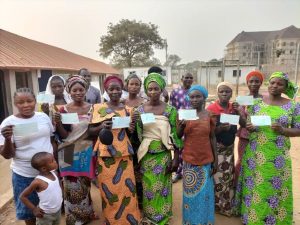 The Christmas Eve rush is almost over, and we begin to prepare ourselves to go across to the Mission Chapel to welcome the Divine Infant at Midnight Mass.
The Christmas Eve rush is almost over, and we begin to prepare ourselves to go across to the Mission Chapel to welcome the Divine Infant at Midnight Mass.
The nurses are tired but that does not prevent them from donning all their new Christmas style. Dressmakers and tailors are kept busy around Christmas, not with tweeds and woollens, but with prints and silks and voiles – for Christmas in the tropics comes at one of the hottest times of the year. I remember one Christmas Day seeing the altar candles wilt with the heat and gradually and gracefully lean sideways until they flopped completely and had to be hurriedly rescued one after the other by the altar boys.
So, in the warm tropical night we set out for the mission compound. Great noisy crowds have gathered round the school and are waiting impatiently for the signal to enter. In the bright moonlight we recognise many old friends and patients. All are dressed in their best. The teachers and nurses who are the belles of the place, and consequently leaders of fashion, cause quite a stir of admiration as they saunter along in their slow, dignified, Nigerian way and stand in groups where they can be seen to advantage. The brightness of the full tropical moonlight enables the admiring audience to get a good view.
The lateness of the hour has not kept the children away. They keep running in and out of the crowds, laughing and noisy while the quieter ones creep into the flower beds and, pulling just the heads of the flowers, string them together on long grass and wear them around their heads and wrists. Sleeping babies nod on their mothers’ backs while mothers sit in groups along the veranda and elsewhere.
Suddenly there is a moment’s hush when the school doors are opened and then the excitement begins again. All are wanting to get in quickly to get to their favourite places in the school. Most of them carry their own stools as the school seats could not possibly accommodate such an unusual crowd. The school has been decorated with palm, flags and banners. The Altar has been prepared with extra special care. There is an air of expectancy about everything and everyone for the gossip outside is not what has brought them here. They are hushed now, attentive and expectant. The priest comes out to the altar, the choir boys begin the “Adeste” and Christmas begins…
by Sr. Jo Anne Kelly MMM Ireland 18.12.2024
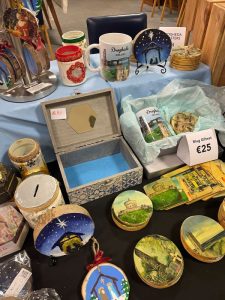
For weeks we had been hearing about the Christmas Craft Fair which would take place in the auditorium in November. In our own house preparations had been going on all year but ramped up in the last few weeks with crochet and knitted articles being completed, inspirational cards made and candles decorated.
Storm Bert was expected for the weekend but that didn’t seem to interfere with anything. Luckily the worst had passed by Saturday morning but it did start off very wet and windy. Tables were already in place and I watched many cars and vans arrive as local crafters came with their own treasures for sale. There was a buzz of excitement .There was such a variety of crafts and what was so tangible was the wonderful spirit of camaraderie and joy among them all. That uplifting spirit continued throughout the day.
After the official opening I walked around to greet people and to see the displays. There was a raffle with great Christmas hampers as prizes. I bought tickets but didn’t win anything. There was a new book for sale, a recently written children’s book about Mother Mary Martin, our Foundress. I was present when a lady from our parish bought beautifully decorated tall red Christmas candles, one for each of the tall window of our local church. I bought a few small things. I was particularly attracted by some small Bookmarks. They were made of a delicate thin wood, with a bright shiny tassel. Written on the wood in fine print was “This is where you fell asleep.” I bought two for friends of mine! – could have bought one for myself as well! There were also beautiful cribs, figures of reindeers and other reminders of Christmas done in a heavier wood and so much else.
During the morning a young group of musicians and singers came. I found a chair at the back and sat down to enjoy the entertainment. A woman came to me and asked “Are you Sr. Jo Anne?” When I said ‘yes’ she told me, “I’m a cousin of yours” and there were two of them.
I have a very big extended family and, since I was many years out of Ireland on mission, I did not get much chance to know the younger generations. The grandmother of these two women was my father’s sister. Both living in the North, they had seen the notice for the Fair on Facebook and thought it might be a chance to meet me. And what a meeting!
A local small bakery and café were providing refreshments at the Fair, so after listening to the children sing for a while, we three went for coffee and buns and they were delicious buns! We had so much to talk about, so much to catch up on. They know lots of relatives I don’t know but I knew lots of family they only heard of. We could have talked all day. They enjoyed meeting the MMM sisters and all our friends and were so impressed with the welcome they received from everyone around. We will meet again soon. Thanks to the Fair we met at all!
The maker of the lovely buns won one of the big Christmas hampers and everyone was delighted.
It was great to meet many of our staff in a different setting and meet some of their children. There was so much chatting and good humour throughout the day. It was a very special day and good to know that some poor and needy people somewhere in the world will have a better Christmas because of this Craft Fair.
I thank God for all in the communications department who organized the Fair and all who helped to give people such an enjoyable and fruitful day.
At this Christmas time may all know in their own hearts the special love and peace that only God can give.
by Sr. Sheila Campbell MMM Ireland 15.12.2024
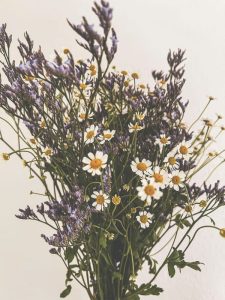 Recently I had the opportunity to meet up with two old friends on separate occasions. One was a priest and the other a widow and busy grandmother. It has led me to think again and joyfully give thanks for the value of these long friendships that date back over many decades to when we were all young.
Recently I had the opportunity to meet up with two old friends on separate occasions. One was a priest and the other a widow and busy grandmother. It has led me to think again and joyfully give thanks for the value of these long friendships that date back over many decades to when we were all young.
Sometime back I wrote a “fable” about love and today I would like to share it. It is called “Bouquet of Love”.
“We want to know of love”, they said. “We want to taste of its delight”. Up and down the village they went, looking for a lover. Down to the village square, up to the church, over to the market and round by the mill stream. No one could find a lover. All they did was bump into one another, mutter some apology, and rush on around the corner.
After some days of futile searching, someone wailed, “Why can’t we find a lover? Have we no experience of love amongst ourselves to guide us in our search?” Thus it was that she was chosen to share what love she had. “You are young enough, close to the taste and smell of it. Tell us what you know.”
She thought for some moments, then asked for time. “My love lives up in the hills, and down there by the river. Let me go and stay with him awhile. I’ll be back to tell you what I can.” They agreed to this and let her go. They asked her to return by mid-summer, at festival time.
Away she went to meet her love. Indeed, she did not have to search for very long, because there he was, sitting under an old oak tree, right at the edge of the woods. Her heart was lightened at the sight of him, and she found comfort in his presence. And yet she sighed. How very curious! She bent to pick a small blue cornflower and said to him, “How can I ever talk about love? It isn’t in the telling.” “Never mind about that”, he said, “Just come and sit beside me for a time. Or rather, let’s gather wildflowers in the woods – see how the blue of that flower dances in your eyes and makes them sparkle.” She smiled at that, and off they went.
As they wandered through the woods, they talked of this and that, laughed at memories of their own foolishness, shared their hopes, their plans, their little fears, and all the while, they picked the wildflowers. There were so many of them, and of such variety that often she stood uncertain how to choose. At these times, he came up behind her, ruffled her hair, and bending down, gathered up an armful, thrusting them into her arms with very little ceremony.
Soon enough, (too soon, she thought), the time arrived for her to return to the village. There was a great bustle of activity taking up the main square, spilling over into the side streets. The whole village gathers once a year for the festival. “The major social event of Anyland”, or so the posters proclaimed. There was a lot of hammering and banging, dragging of tables and food cooking on open fires. The villagers were all in good form. They were laughing, shouting greetings to their neighbours, and haggling for bargains.
“I have come as I promised”, she said, in a suddenly loud voice. All at once the noise quietened. They looked at her expectantly. “I’ve come as I promised”, she said, “to tell you about love. Look and see.” She held out the bouquet of wildflowers. There was a sudden moment of silence. No one knew quite what to do with the gift. Then a motherly sort rustled forward, clasped the girl to her and said, “Why, child, what a pretty bunch of flowers! Now, stick them in the corner there, and come and join the fun.”
All at once the flowers were taken from her hand, and she felt herself propelled forward into the circle of dancers. She wanted to cry out, to step away, but she was firmly held until the dance was over.
The festival lasted late into the night. It was a great success. Everyone proclaimed it to be so, and so it must have been. Finally, alone, she wandered restless along the deserted streets. A mist of loneliness wrapped itself around her. At dawn, she came upon her flowers. Someone had put them into a vase of sorts and left them by the church door. She sat on the steps and stroked each petal. Memory flared. “These are a gift of love,” she whispered to herself. “Will I leave them in the church as a gift to Love Divine?”
As she was thinking this over, an old woman hobbled by. She looked at the flowers and smiled. “They remind me of when I was a girl and climbed the hills,” she said. “And so they shall again”, the younger girl replied. Jumping up, she placed the bouquet in her arms. As she did this a sudden flash of joy came into the old woman’s face and tears fell silently down her cheeks. Both smiled. Each woman turned homeward. Their steps were light. Gifts had been given and received. Love abounded.
by Sr. Siobhan O’Keefe SHJM England 11.12.2024
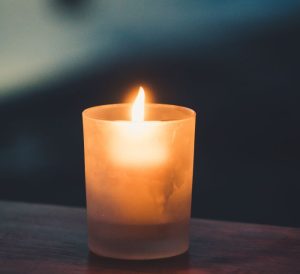 Advent is a season of preparation to deepen our awareness of God’s incarnation and
Advent is a season of preparation to deepen our awareness of God’s incarnation and
divine presence amongst us. A time when we learn of his great love for each one as he
wishes to set us free from all that blocks his divine life in our world today.
In 2024 I have witnessed this advent incarnation lived out in community prayer where
we have desired to deepen our relationship with the living God through silent
contemplative prayer surrendering all to the living God and entering deeper union with
him so that he may be Lord of all.
Through our prayer, sisters have supported each other through good times and bad….
they have embraced their call to ‘BE with each other’ in the daily realities of life helping
each other to hold onto hope and a promise of a new dawn tomorrow.
In ministry they have empowered the most vulnerable in special needs education,
service in food pantries, loving care of the elderly or the homeless and advocated for
the rights of the marginalised at local or national level. They have served as the voice
of the voiceless when they have placed their X on the ballot papers in local and
national elections calling all candidates to respond compassionately to the changing
needs of all whom they are called to serve, upholding their dignity every step of the
way. Care of the environment and respect for all of God’s creation is central to this way
of being.
Earlier this year I reflected deeply on what Advent must have meant to some people
incarcerated in the Auschwitz concentration camp in Poland. I visited this place of
horror with Sister Gabriella from Vienna, one of our SHJM Austrian Federation communities.
She shared with me some of the challenges faced by the peoples of the Eastern bloc
countries under a communist regime. As we walked through the concentration camp,
a scene of the most horrific brutal suffering, I felt that the air was being sucked out of
my lungs by the oppressive atmosphere and I wondered how the victims coped in this
hell hole; what gave them hope as they experienced the worst of man’s inhumanity to
man.
When we arrived at the cell where Fr. Maxmillian Kolbe had lived, I recalled how
he had sacrificed his life so that the father of a family could be saved from execution
by swapping places with him in the gas chamber. A lighted candle giving glory to God
now serves as a memorial of his most humble generosity. This was placed there by
Pope John Paul 11 in June 1979 when he visited Auschwitz which is in the pope’s home
diocese. Pope John Paul dedicated his first Encyclical “Redemptor Hominis” “to the
cause of man, to the dignity of man, to the threats to him, and finally to his inalienable
rights of man.”
The lighted candle was like a resurrection scene at the foot of the cross
and confirmed my hope once more that no matters what horrors plague our world, the
true light of Advent never dims. As we share our Advent journey, I pray that we may bring a little of that light to
each other and all whom we encounter in our service of love.
May it shine ever more brightly for all people in the Jubilee Year of Hope, 2025, Amen.
by Sr. Suzanne Ryder RSM Ireland 08.12.2024
 “Stupid question…” began my friend, as he lowered my suitcase from the attic. I attempted an assurance that there is no such thing as a stupid question, when he finished his query, “…what’s a retreat?”
“Stupid question…” began my friend, as he lowered my suitcase from the attic. I attempted an assurance that there is no such thing as a stupid question, when he finished his query, “…what’s a retreat?”
I don’t believe I had ever asked that question before, taking an answer so much for granted, falling into the trap of presumption. A retreat was something we had in school, when some priest would talk to us every day, and we would be less noisy than usual, enjoying the suspension of regular class.
A retreat was something I did in community every year as a Religious Sister: someone preached every day, television dark, meals eaten in silence.
I remember the clay under the fingernails of the monk who celebrated Eucharist in the early morning in Mount Mellerary Abbey, the Cistercian Monastery in Waterford, when I went there for retreat one year. The words of another monk I visited for a daily chat still echo: “when you come up the hill from the guesthouse,” he said, “it is impossible to arrive in one leap.” I gave surface agreement, but with a heart, resistant to the truth, that I needed to take only one step at a time.
With the passage of years, retreats became more intentional, more creative in style. One on dreams, another exploring art, most touched by music, all graced by the gift of outdoor beauty. Some had a degree of direction (what’s direction?), and latterly, most involve silence…
Today, I am on the precipice of a 30-day retreat, my case still empty. Wavering between anxious trepidation and emerging hope, my friend’s question resounds like a yawning void, anticipating an inevitable drop, while hoping for a hushed whisper of promise or a vague impression of a secret smile.
I could cancel it, couldn’t I? Doesn’t retreat mean to back off or retrace one’s steps? Perhaps it could pass me by before catching me unawares, bringing me to a point of no return?
When birth begins there is no stopping it. Newness will emerge, be it stillbirth or a cry of new life. A risky business. Can I trust being carried by a passing updraft of warm, fresh air, a Godly guffaw, letting go hazardously into a freefall of previously unexplored emptiness?
I had one last swim in the pool this morning before venturing forth tomorrow. Only a few humans were enjoying the calm water so I didn’t need to be concerned that my still learning how to breathe style swimming would be in anyone’s way. Then, emerging from the pool, someone introduced herself, calling me by name. She has no idea how much that healed part of my self-doubt.
Next, I was welcomed into the sauna by some men I meet occasionally, in that steamy place of anonymity. Recklessly, I revealed my plans. A woman keeping silent for thirty days was the source of disbelieving laughter from one of them. A Godly guffaw! A sign! However, again, they will hardly know how I am touched by their words: they will miss me. The case is still to be packed, but that warm laughter has begun a hopeful tremor in my earth-quaking world.
Editor’s Note: Sr. Suzanne Ryder RSM is from the Western Province and this article is re-published with permission.
by Sr. Jo Anne Kelly MMM Ireland 04.12.2024
 I occasionally dip into a favorite book of mine called “Gold in the Memories”, a book that sometimes helps me to find jewels in my own memories. One such memory came to me recently and to me it is precious.
I occasionally dip into a favorite book of mine called “Gold in the Memories”, a book that sometimes helps me to find jewels in my own memories. One such memory came to me recently and to me it is precious.
I received a new and unexpected appointment to do with formation of young sisters. It was shortly after Vatican 11 and so much was changing. As yet no courses on Formation were available so I joined one of the first renewal courses for missionaries. I had never done any theological or scriptural studies and was apprehensive about going into this as I didn’t know what to expect.
On the opening day I arrived at the place, was welcomed, shown my room and invited in for a cup of tea. I went into that room, like a big kitchen, priests and sisters all around a long table all chatting and laughing as if they all knew each other. I was shy then and very self-conscious. I was handed a mug of tea and I tried to greet everyone generally. One man seemed to be the leader and put out his hand to welcome me. As I tried to greet him I tripped on his foot and my mug of tea spilled all over the place. I was mortified and started apologizing. To make light of it he said “O don’t worry that’s my cork leg, I have a cork leg” I was even more apologetic then. There was more laughter, then someone kindly said, “Don’t mind him – he is a Cork man.” It wasn’t a good start for me and I wondered how I was going to get through this whole month.
Of course, as I got to know the group there were others in the same boat as me. The lectures were good, there was a great atmosphere in the group. I made many friends. There one sister in particular, from the same mission area as myself. We became good friends for the rest of our lives, though we don’t meet now as we have grown old. Formation was not a topic mentioned but for me the course was certainly formative. I learnt a lot about myself. It, at least, opened me somehow to a new way of thinking for which I am still grateful.
The last Sunday of that month was a beautiful sunny day. One of the men had a car and invited four of us for a drive to Avoca, the place of “The Meeting of the Waters”. Here the Avonmore and Avon beg rivers meet to form the Avoca River. It was here that the famous Irish poet, Thomas Moore wrote the Irish song “The Meeting of the Waters” It is a place of great natural beauty. Being in the midst of it we were very aware of God, the Creator of so much beauty and prayed for a while.
I cannot remember everything exactly, but as we went down from the main road towards the waters there was a wall or a bridge and on it was written the words of that Irish song. A woman was there alone. She turned to us and said, I would love to sing this song. I don’t want to sing alone would you join me? We had one good singer and the rest of us could sing a bit. We agreed. She started, with a beautiful voice, obviously a professional singer. She encouraged us to sing out and we did with full voices, over the sound of the water. When we finished we stood in silence. Then all of a sudden there was a burst of applause behind us. A busload of American tourists had arrived up on the road. They came quietly down behind us. Thinking we were part of the tourist attraction, those who were late arriving asked us to sing it again! We explained what happened, but we did sing it again and some them joined in. It was a really touching experience.
And I will end my little story with the last verse of that lovely song, quite appropriate for today.
“Sweet Vale 0f Avoca how calm could I rest
In thy bosom of shade with the friends I love best
When the storms that we feel in this cold world will cease
And our hearts like our waters
Will mingle in peace.”
by Sr. Margaret Anne Meyer MMM USA 01.12.2024
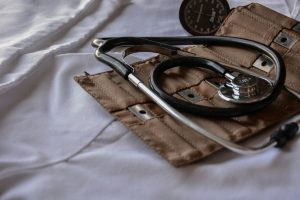 I will never forget the solemn introduction given by the School of Tropical Medicine in Liverpool. We were assembled on an outside terrace and the band played “God Save the Queen”. I felt my heart racing. How could they have stolen our song? Then it dawned on me that we Americans were the stealers and used the same melody for “My Country Tis of Thee”.
I will never forget the solemn introduction given by the School of Tropical Medicine in Liverpool. We were assembled on an outside terrace and the band played “God Save the Queen”. I felt my heart racing. How could they have stolen our song? Then it dawned on me that we Americans were the stealers and used the same melody for “My Country Tis of Thee”.
This was followed by a ‘happy hour’ in which we met the various professors and laboratory assistants. Sister Marin Jones had told me about a good friend of hers to whom she sent slides of malaria parasites. We met easily, and I gave him Sister’s greetings. He told me he remembered her with admiration. I cannot remember his name now, but I remember our conversation. He told me he was an atheist but his friendship with Sister Mairin was his insurance card just to have if, when he died, he found out there were a God. I kept his words to tell Sister Mairin but was shocked to find out that he died of a heart attack that very night. We both prayed for him.
It was hard to settle in without Sister Deirdre Twomey, but I was happy to find that a Holy Rosary Sister Doctor de Paul who had worked in Kenya for many years, was an excellent companion. We did not live in the same residence but ate lunch together. She had many stories to tell me but the words I valued most were about how to go through the fright of not believing in yourself, that you are a qualified doctor and are able to work as one. She assured me everyone has to go through the process. I am grateful to her for this encouragement.
There were many Asian doctors from India and Myanmar doing the course. Some were perplexed and asked me how could Nelson’s Pillar be blown up in Dublin, in a catholic country? I had no answers, but duly told them I had climbed inside the Pillar twice as a tourist. I was wondering how the traffic would manage as all buses in those days seemed to be headed for the Pillar. They also asked a lot of questions about “The Sound of Music” film which had just come out in the cinema. At that time, it was not so easy to go to the movies. I cannot count the times I have seen it since!
I loved traveling on the bus from the Little Sisters of the Poor residence to the School of Tropical Medicine. The bus drivers would often call their passengers “Love”. One day I heard one shouting “Love, you are standing ON THE WRONG SIDE OF THE STREET.” Love. Even the priests in confession would say “How long has it been, love?”
There were many places of interest to travel in Liverpool. I had the opportunity of ascending into a lift to get a closer look at the beautifully stained-glass circular window high above the altar of Liverpool Cathedral. So many shades of blue light radiated down on the main altar. The construction of the Cathedral was almost completed.
It was a great privilege to visit Sr. Anne Merriman’s mother who lived in the vicinity and was most welcoming to all of Anne’s friends.
All the Tropical Medicine subjects were extremely interesting. And we went into them in great detail. I was so happy that remedies were found to cure these diseases as so many of the first missionaries to Africa died of malaria and were sickened by the Tsetse fly.
We had to identify all these insects and one day we had a practical test. The last specimen was a joke. The head of a bumble bee was put on the body of the tsetse fly We could not identify it. The answer given was HUM BUG. One of the doctors from Myanmar said “Humbug? We have not studied Humbug. It is not fair.” We all roared laughing and tried to tell him it was a joke, and the results did not count for our final result.
After twelve weeks we took our final examination and most of us passed. It was time to prepare for the boat ride home to Drogheda and happily go to Uganda on Easter Monday. That is another story.
by Sr. Sheila Devane MMM Ireland 27.11.2024
 Here in our parishes in Ireland we remember our deceased relatives, friends, neighbours and others in the month of November.
Here in our parishes in Ireland we remember our deceased relatives, friends, neighbours and others in the month of November.
We do this in many ways: most churches offer paper lists on which you print the names of those you wish to be remembered and these are then placed before the altar. At most masses there is reference to those deceased people and often too a special mass during the month to remember all our dead. By now I have already written several such lists; I have even gone online and put names in churches and monasteries far away. As soon as I believe the task is done there is another death and in writing that name several others come to mind. This morning while leaving yet another list on the altar in Terenure College Chapel, where I pray, a thought of a different kind of death struck me and I wondered if there was any list or indeed anyone listening to this particular list. Can I share it with you?
This is a list of prayers too but it came about because of the several, now defunct items, here in the house in MMM Templeogue and of the people I have come to know because of these. William came here ten days ago to look at the dishwasher; an excellent model well past its ‘sell by’ date. Yes it has died. No resuscitation possible. There is a new arrival due next week. He asked me to pray for his sister with non-Hodgkin’s lymphoma, a young woman with very tiny twins. He went to say her name, then cried, so I don’t know who she is but Jesus does.
Roger answered the phone of the Hoover Mending Co. in Clondalkin and agreed to look at my little carpet sweeper that was doing everything but what it needed to do i.e. clear up the fluff, crumbs, and carpet dirt! When I met him in person in the shop he said gruffly “a service is needed here“ don’t we all need them?! I agreed, very relieved that a repair was possible. Jason, his two-year-old grandson, is waiting for orthopaedic surgery in Ireland where the waiting list for such is several years long – I have been asked to pray for this request. I certainly will.
Ciarán came to fix the washing machine; a man who never had a lot of formal schooling but has great faith; he suggested we say a decade of the rosary before he began. I agreed and he took a very large set of rosary beads from his toolbox and we prayed together. This was a prayer experience I won’t ever forget. The pump is replaced, the machine working and I could now start a home launderette!
Gavin was going on holidays when I phoned him to say the boiler was not working and therefore I had no heating in November in Ireland; he immediately came along with his 11-year-old son in the van. The little boy wanted to hear “all about Africa” as his father told him that the lady he was going to meet had lived in Africa. I had a great chat with Freddie who said he would prefer to be going to Tanzania now that he knows so much about it instead of to Spain! I am hoping the heating can be fixed and for this I need your earnest prayers.
Yes, indeed, I have a long list of now deceased people to pray for this month; at one point in the past week or two, I felt the list of dying, defunct or dead household items was going to get as long! Thankfully, that hasn’t happened yet, but I now have some people to pray for who I haven’t met, a little boy wanting to hear more about our missions and so much to be grateful for even in this big, domestic mess.
by Sr. Jacinta Mahakwe MMM Nigeria 24.11.2024
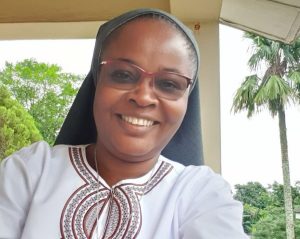
Building connections and relationships is vital for our well-being and happiness. Connection provides a feeling of being part of something larger. After a long time on home leave, I returned to the community and my everyday life. It was my time to take up the house shopping for the month. Our neighbourhood has a grocery store with fresh and cheap foodstuffs. I got everything on my list and went to the counter to pay. There was a smiling face waiting for me. She said, “My friend, it has been a long time. You frequent our shop, but I haven’t seen you for a while. I didn’t know who to ask after you. I missed your smiles and friendly look, my sister.”
I was full of surprise. Feedback from others helps us understand ourselves and I so much appreciated her remarks. Oh, the little moments that slip by. Excited, I told her that I visited my country for the holidays and spent a few months there. She asked questions about my family. She shares some interesting stories she heard about my country in the social media and wanted to learn more. I enquired about her family and work. We exchanged names, contacts and shared ideas and experiences, maintaining connections while learning something new each day from each other.
There are a lot of things lacking in our world today. Some are material, while some are not. Hunger to be seen and heard, hunger for friendship. Mine too, was satisfied. Relationships expose us to new experiences, diversity and knowledge. I learnt more about her while sharing about myself. S he is my friend, yes, my sister. The experience challenges me to engage fully with others, show understanding and compassion, spend time with loved ones, and express appreciation for others. Reaching out and connecting with others builds stronger, more supportive communities and improve communication and conflict resolution. Relationship offer comfort, empathy, and guidance. Investing in connections and relationships enriches our lives and fosters a sense of purpose. Nurture your relationships and prioritize building new ones.
Thank you, my friend, for noticing.
by Nadia Ramoutar MMM Communications Coordinator Ireland 20.11.2024
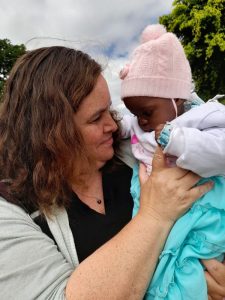 As we get closer to the end of the year, I look forward to Advent and to a winding down of a lot of busyness. But, looking around in the world, there seems to be a lot of noise and I do predict that some of the peace we might want for the season won’t be coming. At least not everywhere. Somethings feel so far gone that peace is more a concept than a reality.
As we get closer to the end of the year, I look forward to Advent and to a winding down of a lot of busyness. But, looking around in the world, there seems to be a lot of noise and I do predict that some of the peace we might want for the season won’t be coming. At least not everywhere. Somethings feel so far gone that peace is more a concept than a reality.
Looking at what it means to be a Christian has also come under fire lately. Political battles have had some casualties and in some families and friend groups there has been a lot of hostility. We could ask ‘what will it take to overcome this?’
Perhaps at times like this the best thing to do is to fall back to basics. What does the Lord require of me? The answer is literally given to us in Micah 6:8.
‘What does the Lord require of you
But to do justice and to love kindness
And to walk humbly with your God.’
It could not really be more straightforward. We are given a very clear request that seems to cause humans a lot more trouble than would be expected. So when there is angst and we are provoked or annoyed by other people, this is such an important reminder for us to simplify. We can be easily manipulated or upset sometimes because we are not being as kind to ourselves as we could be. Self-care is an important practice in being able to walk humbly.
Going for a walk and making it part of our daily spiritual practice can be a great choice as it allows us to reconnect with nature and to breathe fresh air. We may find ourselves less aggravated when we ‘do justice’ and make choices based on this. Justice as a something we do, not just think is very important.
As stress increases and we get caught up in what other people are saying, we might feel entitled to be unkind or to not take action at all. There is no doubt that some people would literally annoy a Saint. In knowing our own limits and our own triggers we can shift our focus and look for glimmers of love and hope instead.
To love kindness is a great goal on the worst of days. It is a short cut to freedom from oppressive negativity. We can win every time when we chose to be kind. It is always a choice available to us.
